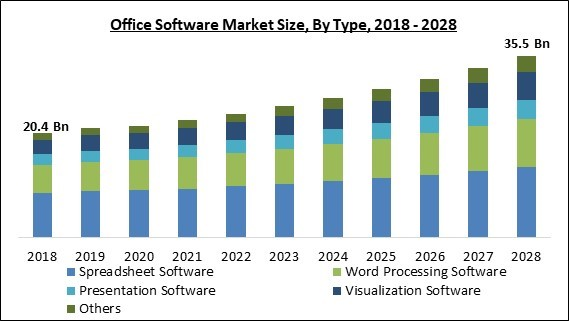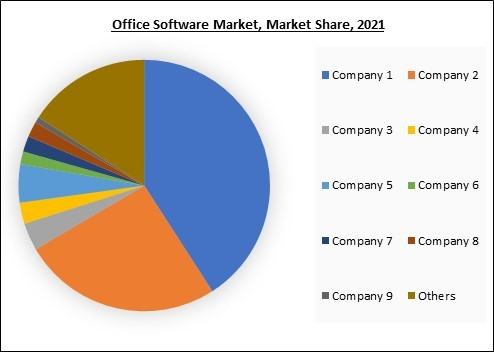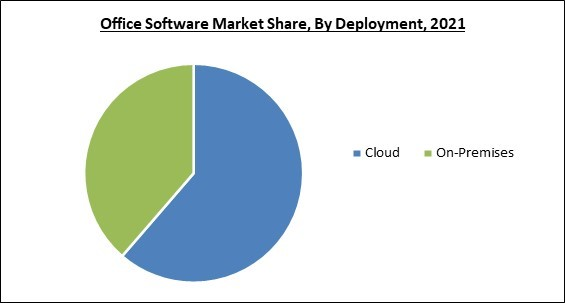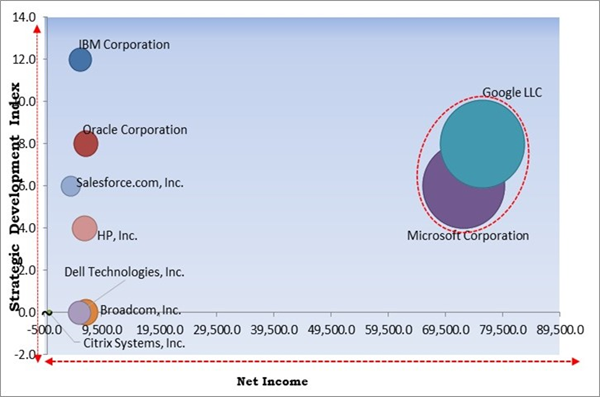The Global Office Software Market size is expected to reach $35.5 billion by 2028, rising at a market growth of 6.5% CAGR during the forecast period.
Office Software refers to a set of office productivity tools used to create documents, spreadsheets, presentations, and other functions. The majority of standard office software suites consist of presentation programs, word processors, and spreadsheet programs. In recent years, the trend in this industry has been away from installed and licensed software items and toward online products accessed via the Internet and paid for on an annual or monthly basis. Microsoft Office has dominated the office software market for decades.
Office software includes spreadsheets, database administration, and email. Common office software is readily accessible from manufacturers as part of bundled sets. An office suite, often known as an office software suite and productivity suite, is a set of productivity applications designed for knowledge workers. The components are typically deployed together, have a uniform user interface, and can frequently interact in ways that the operating system would not otherwise permit.
Modern offices are increasingly turning to cloud computing for their rapidly and significantly evolving requirements. The cloud is synonymous with cloud computing. Cloud storage is an internet repository. With the cloud, it is possible to store and distribute data throughout the entire office, hence decreasing the requirement for physical storage space. Utilizing the cloud is much more secure than physically storing data in an office. By storing everything in digital format and storing it remotely, there is no risk of theft. The cloud can facilitate considerably simpler connections between individuals or departments inside an enterprise. The cloud enables them to connect with each other and provides simpler access to papers, allowing numerous users to collaborate on and modify documents without the need for a physical copy.
The leading players in the market are competing with diverse innovative offerings to remain competitive in the market. The below illustration shows the percentage of revenue shared by some of the leading companies in the market. The leading players of the market are adopting various strategies in order to cater demand coming from the different industries. The key developmental strategies in the market are Acquisitions.
The major strategies followed by the market participants are Acquisitions. Based on the Analysis presented in the Cardinal matrix; Google LLC and Microsoft Corporation are the forerunners in the Office Software Market. Companies such as IBM Corporation, Oracle Corporation and Salesforce.com, Inc. are some of the key innovators in Office Software Market.
The market research report covers the analysis of key stake holders of the market. Key companies profiled in the report include Microsoft Corporation, Google LLC, IBM Corporation, Oracle Corporation, Salesforce.com, Inc., Broadcom, Inc. (Symantec Corporation), Dell Technologies, Inc., HP, Inc., and Citrix Systems, Inc.
Office Software refers to a set of office productivity tools used to create documents, spreadsheets, presentations, and other functions. The majority of standard office software suites consist of presentation programs, word processors, and spreadsheet programs. In recent years, the trend in this industry has been away from installed and licensed software items and toward online products accessed via the Internet and paid for on an annual or monthly basis. Microsoft Office has dominated the office software market for decades.
Office software includes spreadsheets, database administration, and email. Common office software is readily accessible from manufacturers as part of bundled sets. An office suite, often known as an office software suite and productivity suite, is a set of productivity applications designed for knowledge workers. The components are typically deployed together, have a uniform user interface, and can frequently interact in ways that the operating system would not otherwise permit.
Modern offices are increasingly turning to cloud computing for their rapidly and significantly evolving requirements. The cloud is synonymous with cloud computing. Cloud storage is an internet repository. With the cloud, it is possible to store and distribute data throughout the entire office, hence decreasing the requirement for physical storage space. Utilizing the cloud is much more secure than physically storing data in an office. By storing everything in digital format and storing it remotely, there is no risk of theft. The cloud can facilitate considerably simpler connections between individuals or departments inside an enterprise. The cloud enables them to connect with each other and provides simpler access to papers, allowing numerous users to collaborate on and modify documents without the need for a physical copy.
COVID-19 Impact Analysis
The COVID-19 pandemic caused severe damage to various economies all over the world. Several businesses throughout the world were majorly disrupted. In addition, a number of companies as well as manufacturing facilities were shut down during the outbreak. All of these factors led to economies to a steep downfall. However, the office software market witnessed exponential growth during the pandemic as a result of paradigm changes across a number of industries. Due to the lockdowns imposed by many countries' governments during the COVID-19 pandemic, businesses were compelled to utilize WFH models.Market Growth Factors
Enhanced efficiency and higher accuracy
Maintaining consistent production is the objective of every business. The greater the productivity, the more commodities a company produces for its consumers, and the greater overall revenue can be attained eventually. A back-office solution streamlines and automates inventory management, accounting, and payroll distribution, among other tasks. Different departments receive information or updates in real-time, preventing uncertainty and miscommunication. Users can effortlessly create and print receipts, packing slips, invoices, shipping labels, and other documents and paperwork. If a business specializes in shipping products to consumers, it must locate appropriate shipping labels and enter information appropriately. Therefore, the higher efficiency of office software along with its superior precision is significantly stimulating the growth of the office software market.Offers high-quality collaborations along with increased customer satisfaction
Maintaining clear communication with employees, external and internal stakeholders, managers, partners, clients, and other corporate participants is essential for ensuring the successful operation of the company. If a business needs to have team meetings for updates, ice-breakers, training, and other purposes, it is essential to have effective communication tools. This solution offers valuable ways to integrate with team-centric applications, such as Slack and Trello, and allows people to capture useful information so that everyone can swiftly and easily communicate vital information, questions, comments, and more. Hence, augmenting the growth of the office software market.Marketing Restraining Factor
Risk of security breaks and software malfunctions
One of the major factors that are disrupting the growth of the office software market is the prevalence of a number of security concerns in the utilization of software. Digital records are susceptible to illegal access, whether through hacking or insufficient worker security. Especially where negligence is involved, the loss of important medical and legal records can result in considerable liabilities for the affected company. Specifically, in a shared network context, the disposal of digital assets provides a unique challenge. Erasing a file does not totally remove a digital record, just as throwing away a physical document does not prevent someone from accessing it later. Therefore, this factor is hampering the growth of the office software market.The leading players in the market are competing with diverse innovative offerings to remain competitive in the market. The below illustration shows the percentage of revenue shared by some of the leading companies in the market. The leading players of the market are adopting various strategies in order to cater demand coming from the different industries. The key developmental strategies in the market are Acquisitions.
Type Outlook
By Type, the Office Software Market is categorized into Spreadsheet Software, Word Processing Software, Visualization Software, Presentation Software, and Others. In 2021, the visualization software segment procured a substantial revenue share of the office software market. Due to the rising use of new technologies in product design and development, the industry is anticipated to expand. In addition, the adoption of user-friendly software interfaces as well as the intensification of competition is projected to enhance demand for these software solutions.Deployment Outlook
On the basis of Deployment, the Office Software Market is bifurcated into Cloud and On-premises. In 2021, the on-premises segment garnered a substantial revenue share of the office software market. On-premise deployment is gaining popularity due to its capacity to provide enterprises with comprehensive service and software management. Once the license copy of the product is provided by the vendor at the time of deployment, the organization has total access to and control over its data and maintenance.Regional Outlook
Region-Wise, the Office Software Market is analyzed across North America, Europe, Asia-Pacific, and LAMEA. In 2021, North America accounted for the largest revenue share of the office software market. The office software solution is anticipated to grow faster in North America due to reasons, such as the region's rising adoption of enterprise office software along with cloud computing technologies as well as solutions. In addition, the growth of small businesses and rising SME expenditures in the SaaS and cloud industry are anticipated to drive market growth.The Cardinal Matrix - Office Software Market Competition Analysis
The major strategies followed by the market participants are Acquisitions. Based on the Analysis presented in the Cardinal matrix; Google LLC and Microsoft Corporation are the forerunners in the Office Software Market. Companies such as IBM Corporation, Oracle Corporation and Salesforce.com, Inc. are some of the key innovators in Office Software Market.
The market research report covers the analysis of key stake holders of the market. Key companies profiled in the report include Microsoft Corporation, Google LLC, IBM Corporation, Oracle Corporation, Salesforce.com, Inc., Broadcom, Inc. (Symantec Corporation), Dell Technologies, Inc., HP, Inc., and Citrix Systems, Inc.
Recent Strategies Deployed in Office Software Market
Partnerships, Collaborations and Agreements:
- Jul-2022: Oracle came into a partnership with Microsoft, an American multinational technology corporation. Under this partnership, the companies aimed to launch the dubbed Oracle Database Service for Azure, a service, which enables Azure customers to directly access Oracle databases over Oracle Cloud Infrastructure.
- Jun-2020: Microsoft partnered with SAS, a leader in analytics. Under this partnership, the companies would enable customers to operate their SAS workloads on Microsoft Azure intending to help customers in expediting growth along with discovering novel approaches to accelerate innovation.
- May-2022: Oracle entered into a partnership with Informatica, a leader in enterprise cloud data management. Through this partnership, the companies aimed to allow customers to leverage Informatica's best-in-class data integration and governance tools over the Oracle Cloud Infrastructure.
Acquisitions and Mergers:
- Aug-2022: HP took over Poly, a leader in providing workplace collaboration solutions. Following this acquisition, the company aimed to further accelerate HP’s vision to develop a more growth-centered portfolio in order to strengthen its industry potential within the hybrid work solutions market.
- Mar-2022: Microsoft acquired Nuance Communications, ambient intelligence, and conversational AI leader. Through this acquisition, the company aimed to integrate Nuance’s leading ambient intelligence and conversational AI capabilities into its portfolio of reliable and secure cloud to aid vendors in offering more effective, accessible, and affordable healthcare services and devices.
- Feb-2022: IBM acquired Neudesic, a cloud services consultancy. Following this acquisition, the company aimed to leverage Neudesic's capabilities into its offerings in order to expand its hybrid multi-cloud services portfolio.
- Dec-2021: Oracle acquired Cerner, a health information technology services provider. Through this acquisition, Oracle aimed to offer advanced and simple digital tools to medical professionals to enable access to information to secure cloud applications through a hands-free voice interface. In addition, it would allow the company to address the challenges of overworked medical professionals.
- Jul-2021: Salesforce took over Slack Technologies, a Canadian international software company. With this acquisition, the company aimed to redefine the future of enterprise software to develop a digital HQ that allows companies to offer remote success to employees and customers.
- Dec-2020: IBM took over Instana, a leader in application performance monitoring and observability. With this acquisition, the company aimed to strengthen its Watson AIOps portfolio through a constant flow of information to deliver higher-quality recommendations via its AI models.
- Jan-2020: Google took over AppSheet, a no-code mobile application-building platform. Through this acquisition, the company aimed to streamline the process of developing applications without the requirement for any coding capabilities. In addition, this acquisition would aid businesses in empowering a number of developers to conveniently create as well as extend applications without the requirement for professional coding skills.
Scope of the Study
By Type
- Spreadsheet Software
- Word Processing Software
- Presentation Software
- Visualization Software
- Others
By Deployment
- Cloud
- On-Premises
By Geography
- North America
- US
- Canada
- Mexico
- Rest of North America
- Europe
- Germany
- UK
- France
- Russia
- Spain
- Italy
- Rest of Europe
- Asia Pacific
- China
- Japan
- India
- South Korea
- Singapore
- Malaysia
- Rest of Asia Pacific
- LAMEA
- Brazil
- Argentina
- UAE
- Saudi Arabia
- South Africa
- Nigeria
- Rest of LAMEA
Key Market Players
List of Companies Profiled in the Report:
- Microsoft Corporation
- Google LLC
- IBM Corporation
- Oracle Corporation
- Salesforce.com, Inc.
- Broadcom, Inc. (Symantec Corporation)
- Dell Technologies, Inc.
- HP, Inc.
- Citrix Systems, Inc.
Unique Offerings
- Exhaustive coverage
- The highest number of market tables and figures
- Subscription-based model available
- Guaranteed best price
- Assured post sales research support with 10% customization free
Table of Contents
Chapter 1. Market Scope & Methodology
Chapter 2. Market Overview
Chapter 3. Competition Analysis - Global
Chapter 4. Global Office Software Market by Type
Chapter 5. Global Office Software Market by Deployment
Chapter 6. Global Office Software Market by Region
Chapter 7. Company Profiles
Companies Mentioned
- Microsoft Corporation
- Google LLC
- IBM Corporation
- Oracle Corporation
- Salesforce.com, Inc.
- Broadcom, Inc. (Symantec Corporation)
- Dell Technologies, Inc.
- HP, Inc.
- Citrix Systems, Inc.
Methodology

LOADING...
Table Information
| Report Attribute | Details |
|---|---|
| No. of Pages | 189 |
| Published | October 2022 |
| Forecast Period | 2021 - 2028 |
| Estimated Market Value ( USD | $ 23016 Million |
| Forecasted Market Value ( USD | $ 35519 Million |
| Compound Annual Growth Rate | 6.5% |
| Regions Covered | Global |
| No. of Companies Mentioned | 9 |












